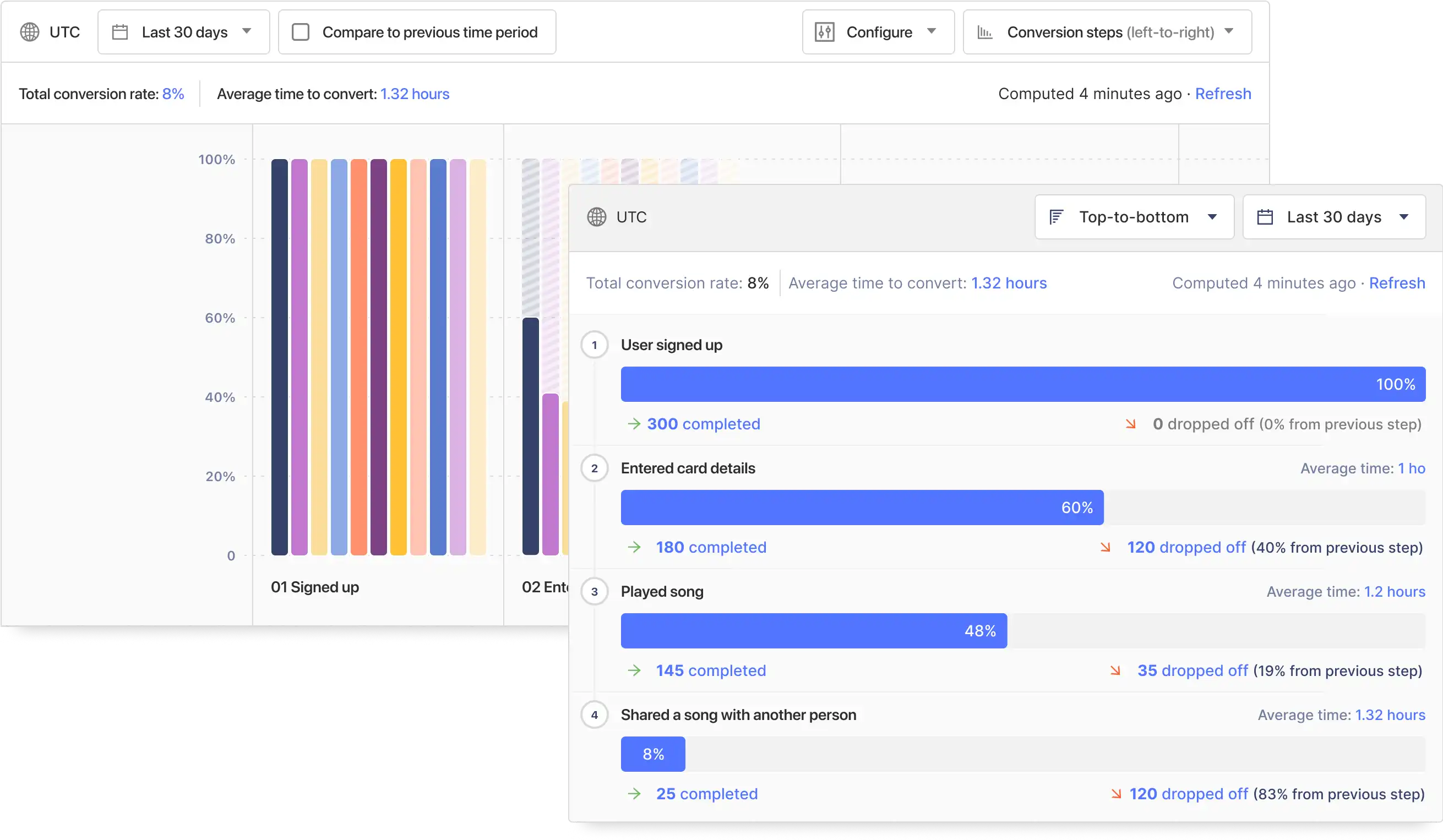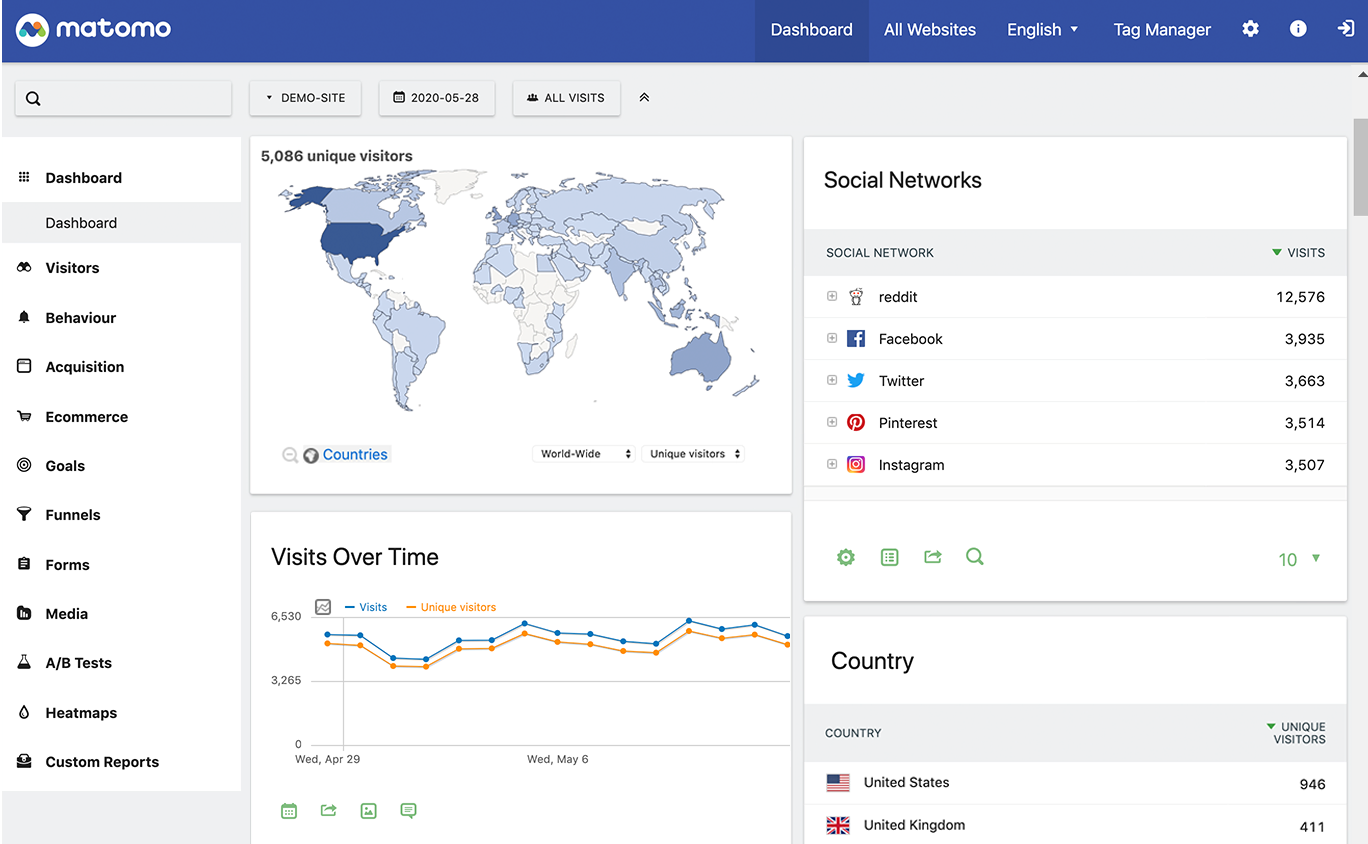PostHog and Matomo are both open-source analytics platforms you can self-host on your own infrastructure, giving you complete control over your data and unrivaled privacy compliance. However, there are some important differences between the two platforms.
Matomo is primarily pitched as a Google Analytics alternative for marketing analytics, and offers useful tools for migrating GA data into Matomo for a seamless transition. Its focus on session tracking makes it ideal for running analytics on large content and e-commerce websites
In contrast, PostHog is a comprhensive Product OS that includes product analytics, session recording, feature flags, experimentation, and much more.
Contents:
- How is PostHog different to Matomo?
- PostHog vs Matomo feature comparison
- Integrations and data sources
- Strengths of PostHog
- Strengths of Matomo
- Coming soon to PostHog
How is PostHog different from Matomo?
1. It's an all-in-one platform
Matomo charges extra for product analytics features like funnel analysis, cohorts, path analysis, and session recording, and they're not tightly integrated. In PostHog, these are core features in all editions, including the open source release, while Experimentation is free up to 1 million events per month.
2. Seamless integration with modern data stacks
PostHog is built to work seamlessly with your data stack. That means we offer data import and export integrations with most popular data warehouses, as well as numerous integrations with CRMs (Hubspot, Salesforce), data platforms (Segment, Airbyte, Rudderstack), engineering tools (PagerDuty, Sentry), and more via the PostHog App Store.
3. It's built for engineers
PostHog is about giving engineering and product teams the tools they need to build better products. The core product analytics tools are part of this, but we go further by providing market-leading feature flag functionality, and integrating Session Recording so you can deploy one platform that does everything, rather than integrating multiple discrete tools into your stack.
Feature comparison
This table compares three self-hosted plans: Matomo On-Premise, PostHog Open Source, and PostHog Cloud.
Matomo On-Premise ships with a robust set of core web analytics features, while advanced product analytics features are available at various prices from the Matomo On-Premise Marketplace.
All features in PostHog Open Source are totally free, including core product analytics tools.
PostHog Cloud adds experimentation, group analytics, and support for multiple projects. It's free to use up to 1 million events per month.
| Matomo On-Premise | PostHog Open Source | PostHog Cloud | |
| Platform | |||
| Open source | ✔ | ✔ | ✔ |
| Host yourself | ✔ | ✔ | ✔ |
| 1st-party cookies | ✔ | ✔ | ✔ |
| Custom apps | ✔ | ✔ | ✔ |
| Multiple projects | ✔ | ✖ | ✔ |
| Unlimited users | ✔ | ✔ | ✔ |
| Event autocapture | ✖ | ✔ | ✔ |
| GDPR compliance | ✔ | ✔ | ✔ |
| HIPAA compliance | ✔ | ✔ | ✔ |
| API access | ✔ | ✔ | ✔ |
| Cookie-less option | ✔ | ✔ | ✔ |
| Features | |||
| Feature Flags | ✖ | ✔ | ✔ |
| Retention tracking | ✖ | ✔ | ✔ |
| Unique user and pageview tracking | ✔ | ✔ | ✔ |
| UTM tracking | ✔ | ✔ | ✔ |
| User profiles | ✔ | ✔ | ✔ |
| Funnel analysis | 179 to 529 EUR pa | ✔ | ✔ |
| Cohorts | 89 to 259 EUR pa | ✔ | ✔ |
| Path analysis | 89 to 259 EUR pa | ✔ | ✔ |
| Multi-Channel attribution | 79 to 229 EUR pa | ✖ | ✖ |
| Session Recording & Heatmaps | 199 to 599 EUR pa | ✔ | ✔ |
| Experimentation | 199 to 599 EUR pa | ✖ | ✔ |
| Roll-up reporting | 199 to 599 EUR pa | ✖ | ✖ |
| Hedgehogs | ✖ | ✔ | ✔ |
Integrations and data sources
Matomo doesn't offer many dedicated integrations for syncing data with other platforms, but its Tracking and Reporting APIs allow you to query a large range of parameters. It also offers a Google Analytics importer.
In addition to extensive selection of dedicated integrations, PostHog offers two APIs: a public API for pushing data into PostHog, and a private API for exporting data and performing various actions.
| Matomo | PostHog | |
| Export | ||
| API | ✔ | ✔ |
| Redshift | ✖ | ✔ |
| Google Cloud Storage | ✖ | ✔ |
| Snowflake | ✖ | ✔ |
| Amazon S3 | ✖ | ✔ |
| Google BigQuery | ✖ | ✔ |
| Google Pub/Sub | ✖ | ✔ |
| RudderStack | ✖ | ✔ |
| Hubspot | ✖ | ✔ |
| Sentry | ✖ | ✔ |
| Zapier | ✖ | ✔ |
| Hubspot | ✖ | ✔ |
| Salesforce | ✖ | ✔ |
| Import | ||
| Google Analytics | ✔ | ✖ |
| API | ✖ | ✔ |
| Redshift | ✖ | ✔ |
| Google Cloud Storage | ✖ | ✔ |
| Snowflake | ✖ | ✔ |
| Amazon S3 | ✖ | ✔ |
| Sentry | ✖ | ✔ |
| Hubspot | ✖ | ✔ |
| Salesforce | ✖ | ✔ |
| Zapier | ✖ | ✔ |
| Zendesk | ✖ | ✔ |
Strengths of PostHog

Combining feature flags and product analytics
Feature flags are at the core what makes PostHog a great tool for product-lead businesses. They're especially useful for gradually rolling out new features, and quickly rolling back if you detect problems, but they can be used in other creative ways.
Need feedback on a design change? Roll it out to internal users first to gather feedback. Need to optimize messaging for different regions or demographics? Use a feature flag targeted on user properties. Want to change something without the CEO noticing? Create a flag just for them. Ok, we don't actually recommend the latter, but you get the idea.
Feature flags also integrate with other analytics insights, so you can breakdown a conversion funnel by a feature flag, or filter trends, paths, and numerous other insights by specific feature flags. Using Feature Flags and product analytics together gives developers a complete toolset.
Automatic event tracking
PostHog and Matomo both support event tracking, but PostHog goes one step further by autocapturing events so you don't have to instrument every single thing before you start tracking it. This means you start capturing useful data from the moment you deploy PostHog, but it also makes rolling out updates much easier as you don't have to define your events each time.
Strengths of Matomo

E-commerce and marketing analytics
Matomo is especially well-suited to content and e-commerce websites. Unlike Google Analytics, it doesn't employ any data sampling, and it offers a wide-range of features specifically designed to aid marketing teams. For example, Matomo's Multi Channel Conversion Attribution reports (a paid feature) allow marketing teams to understand how all their activities impacted a conversion, not just the last interaction.
Integration with popular content management systems
Matomo is ideal for anyone who uses popular off-the-shelf content management systems or e-commerce platforms. Websites with fewer than 50,000 page views per month can safely install Matomo straight from the WordPress plugin library, and Matomo offers an official integration with WooCommerce as well. There are community integrations for numerous other platforms, including Drupal, Joomla, DatoCMS, Pimcore, and Adobe Commerce.
Coming soon to PostHog
We ship weirdly fast. Here's a quick snapshot of what we're working on right now:
- SOC 2 compliance
- PostHog Customer Data Platform
- See Users & Recordings linked to feature flags (GitHub issue)
- Direct access to data via SQL (GitHub issue)
- Universal search for people, recordings, cohorts, events, and groups (GitHub issue)
- Feature flags platform for Android, iOS and Flutter
- Mobile session recordings
- Interlinking recordings and analytics
You can view and vote on issues on our public roadmap.
You can also take a look at recent issues and pull requests on the PostHog repo to see what we're working on.
At PostHog, nearly everything we do is done in the open. You can chat with our engineers directly in the community Slack, or ask them questions on any of our docs pages.
You can read all about how we work in our company handbook.
Ready to find out more?

